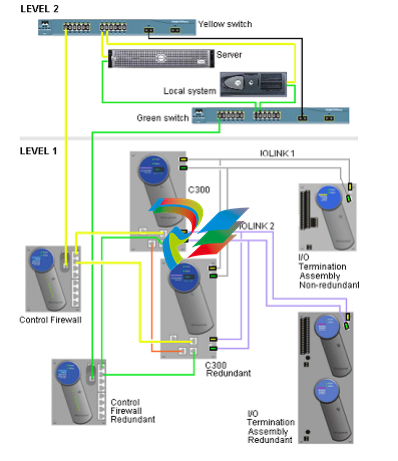
HoneywellEXPERION PKSSeries C I/O User's Guide EPDOC-X126-en-A November 2019
l On board excitation power (no need for marshalling power)
l Direct / Reverse Input Indication
Galvanic isolation
Direct Output
bussed 24Vdc
l Extensive self-diagnostics
l Functional redundancy
l Output direct/reverse
l Safe-state (FAILOPT) behaviors
l Each channel can be configured to HOLD, LAST, VALUE, or
SHED to a SAFE VALUE.
l Fuse-less short circuit protection
allows a short circuit to exist without blowing any fuses. When a particular
channel is shorted, internal circuits detect this and remove power to the
I/O
module/IOTA
Feature/function
field connection. The channel remains de-energized until the short circuit
is repaired
l Latched, pulsed or pulse-width modulated output
l Galvanic isolation
l Output read back checking to screw terminal
Digital Output -
Relay IOTA
l Galvanic isolation
l Counter EMF snubbing circuit
l Isolated dry contact (Form A or B)
l Output read back checking on system side of driver
Low Level
Analog
(temperature)
Input - LLMUX
l TC and RTD operation
l Remote cold junction capability
l 1 Second PV scanning with OTD protection
l Configurable OTD protection (See below)
l Temperature points can be added in 16 point increments
Low Level
Analog
(temperature)
Input - LLAI
l Thermocouple (TC) and RTD operation
l 1 Second PV scanning with Open Thermocouple Detection (OTD)
protection
l Configurable OTD protection
Speed
Protection
Module - SP
l Supports 2/3 voting logic for speed and acceleration.
l Supports multiple configurable trip limits for speed and acceleration.
Servo Valve
Positioner
Module - SVPM
l Supports PID execution and position calibration.
l Computes valve position from LVDT/RVDT input signal and controls valve
by signaling the Servo coil.
l Provides current modulation to avoid stiction in controlled device (servo
valve).
Pulse Input
Module - PIM
l Highly accurate frequency/period calculations.
l Supports Dual Pulse Integrity in accordance with ISO6551:1996 Level A for
custody transfer applications.
l Extensive self-diagnostics.
l Functional redundancy.
l Provides channel-to-channel and terminal block to backplane voltage
isolation.
Universal
Input/Output
Module - UIOM
l Extensive self-diagnostics
l Optional redundancy
l Independently configurable I/O channels
l controls DI, AI, DO, AO
l HART capable, multivariable instruments
l PV protection through a broken-wire detection diagnostic
l Safe-state (FAILOPT) behaviors
l Supports multiple channel configurations
UIO-2
I/O
module/IOTA
Feature/function
In addition to all features supported by UIO, the UIO-2 supports the folowing
additional features:
l Provides one HART modem per I/O channel
l Supports pulse counting on up to four of any of the 32 channels
configured as DI
l Supports DO ganging within the following eight channel number groups: 1
- 4, 5 - 8, 9 - 12, 13 - 16, 17 - 20, 21 - 24, 25 - 28, and 29 – 32. However,
ganging across these groups is NOT possible
Beginning with ExperionR501, the following new features are available:
l Supports SOE on any channel
l Supports NAMUR inputs. This function, however, will require external
voltag
Series C I/O and C300/CN100 topology
ATTENTION
Topology for the Series C I/O and C300 - 20mS CEE Controller is similar to the Series C I/O
and C300 - 50ms Controller, with the exception that the C300 - 20mS CEE Controller does
not support the PMI/Os. CN100 supports all the Series C family of I/Os with the exception of
SPM and SVPM.
Series C I/O is attached to an IOLINK that is being mastered by a C300 controller. It is important to
note that:
l IOLINK - Serves as data repository for IOM function blocks in Control Builder to provide
communications interface with Series C I/O.
l Series C I/O cannot reside on an IOLINK mastered by an IOLIM or xPM.

Examining the topology rules
The following are the topology rules relating to the Series CI/O environment.
Refer to the following document for graphical representations of cabinet layouts depicting Series
C, PMIO, FIM, and LLMUX hardware configurations. Control Hardware Planning Guide
Item Impact Description
Redundancy None Redundancy capacity and performance is displayed while
redundancy is present.
Switchover Same as PM
I/O
Series C I/O hardware and/or software can switchover, recover,
and resume full view in a timeframe no greater than PM I/O.
Initialization All Series C I/O
per
C300/CN100
Can be initialized in 60 seconds (+/- 25%) after cabinet-level loss
power loss.
I/O module Can be initialized in 10 seconds (+/- 25%) after IOM level loss
power loss.
Multiple I/O
Links
2 Design allows the use of multiple Series C I/O Links in the same
cabinet.
tem Impact Description
I/O Link
performance
None I/O Link networks perform at the current distance and IOP count
specifications.
I/O Link
capacity
40 max Maximum of 40 redundant IOMs per link
(for either Series C I/O or PM I/O).
IOMs / C300 64 max Maximum of 64 redundant IOMs per C300 (for PM I/O).
80 max Maximum of 80 redundant IOMs per C300 (for Series C I/O).
Series C and
PM I/O -
combined
64 Design supports Series C and PM I/O FTAs in the same side of the
cabinet. Current configuration prevents IOTA and FTAs in the
same column.
I/OMs/CN100 40 Max Maximum of 40 redundant I/OMs per CN100
3.3 Supported Series C I/O modules
The list of I/O modules below can be used on a Series C IOLINK. The IOLINK contains a function




























































































































